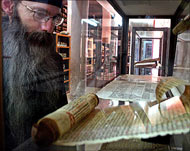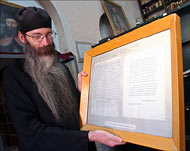Monks use hi-tech on ancient texts
The world’s oldest monastery has plans to use hi-tech cameras to shed light on ancient Christian texts preserved for centuries within its fortress walls in the Sinai desert.

Saint Catherine’s Monastery hopes the technology will allow a fuller understanding of some of the world’s earliest Christian texts, including pages from the Codex Sinaiticus – the oldest surviving bible in the world.
The technique, known as hyper-spectral imaging, will use a camera to photograph the parchments at different wavelengths of light, highlighting faded texts obscured by time and later over writings.
It should allow scholars to understand corrections made to pages of the Greek Codex Sinaiticus, written between CE 330 and 350 and thought to be one of 50 copies of the scriptures commissioned by Roman emperor Constantine.
“If you look at all the corrections made by each scribe then you can come out with a principle on which he was correcting the text,” said monastery librarian Father Justin.
In a joint project with the monastery, libraries in Britain, Germany and Russia, which together hold the bulk of the manuscript, will also scan pages and fragments of the text to digitally reunite the work in a facsimile.
Forgotten manuscript
The monastery had kept the Codex Sinaiticus until the mid-19th century, when the bulk of it was taken to Russia by a German scholar and never returned. Russia sold those pages in 1933 to the British Library, where they are still kept.
 |
|
The monastery wants to build a |
The monks thought they had lost the entire manuscript to Europe until 1975, when they discovered 12 of its pages and 15 fragments in a forgotten chamber, buried under a collapsed ceiling with thousands of other parchment leaves and fragments.
The monastery, which has never lost hope the manuscript may be returned, has agreed to take part in the project on condition it includes a modern history of the Codex.
The Greek Orthodox monks keep a framed copy of a note left by the German scholar promising to return the manuscript.
Unpublished documents in Russian archives could shed light on the circumstances in which the text left the monastery.
Russia might have a document showing the monks sold or donated the Codex. But questions would remain on whether any such document was obtained under duress, Father Justin said.
“If they find such a document, maybe in their archives, then we must accept it. If not, we have rights. But even if there is such a document, how was it obtained?” Saint Catherine’s Archbishop Damianos asked.
Restoration
Pages of the Codex Sinaiticus in Britain and Germany are in good enough condition to be photographed straightaway, but those in the monastery need restoration to ready them for the process.
“Some of them are crumpled in the state they were found in and they need to be opened up,” said book historian Nicholas Pickwoad, an adviser to the monastery’s conservation project.
The monastery plans to build a conservation workshop to treat the Codex and other works in its collection of 3304 manuscripts and 1700 scrolls, which make up the biggest collection of early Christian texts outside the Vatican.
It will also build a new library to house the collection, preserved by the monastery’s remote location, a dry desert climate and the care of the monks. “There is nothing else quite like this collection. It doesn’t compare,” Pickwoad said.
Ancient manuscripts
Hyper-spectral imaging will be used to read another one of the monastery’s most significant manuscripts – the Codex Syriacus.
The technology should allow scholars to read the faint remnants of a washed-out 5th-century text that lie underneath visible 8th-century writing. The underlying text in Syriac is a copy of a second century translation of the New Testament gospels.
 |
|
A German scholar took the Codex |
In the late 19th century, scholars applied chemicals to the manuscript that briefly made the underlying text visible but made the parchment more brittle. “It’s almost certain that the whole text has not been extracted yet,” Pickwoad said.
Photographing the rippled parchment may involve using up to “four cameras taking images from different angles and then knitting the image together, electronically pulling it flat because we may not be able to pull it flat physically,” he said.
The technology could also be applied to read the faint traces of a script in a language only ever seen before carved in a few stone inscriptions. It lies in the pages of a Georgian manuscript dating to the 8th or 9th century.
Available online
Father Justin, who is from Texas in the United States, has started digitising some of the monastery’s better preserved manuscripts, using a camera that can take extremely high resolution photographs.
“When I came to Sinai, I came to live in the desert. I didn’t know I’d be doing computer photography and going to London four times a year,” he said.
The monastery aims to have 100 manuscripts photographed and accessible through a website by mid-2006. “Even though it’s only 100 out of 3000, it will be an important scholarly resource,” he added.
Book historians are cataloguing the condition of the manuscripts and the physical features of their bindings, half of which are original.
“The evidence of where a manuscript has been and where it has come from to get here is often in the binding,” Pickwoad said.
Conservators are even keeping the dust they brush from the manuscripts for traces of pollen or seeds that may yield evidence on how texts in languages including Persian, Amharic (a language found in Ethiopia) and Hebrew made it to the middle of the Sinai desert.